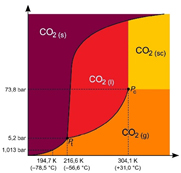Carbon dioxide CO2: Explosive decompression – elastomeric seals during decoupling
The destructive “explosive decompression” (AED / Anti-Explosive Decompression) of gases, and in particular of CO2, impacts a wide variety of applications in various industries and can cause loss of function to pressure-bearing components if no special precautions are taken.
This is why the seals essentially affected and all other components used must be resistant to explosive decompression
Carbon dioxide – a highly complex medium
CO2 is a highly complex medium which, depending on pressure and temperature, can be solid (=ice), liquid, gaseous and supercritical (density similar to a liquid with a viscosity similar to gas). See phase diagram of carbon dioxide (not to scale).

Phasendiagramm der festen (s), flüssigen (l), gasförmigen (g) und überkritischen (sc) Phase von Kohlenstoffdioxid
What causes explosive decompression in elastomers?
For a long time, WALTHER-PRÄZISION has been working on the physical mechanism that is partly decisive for the service life of quick couplings. When selecting the O-rings of our quick coupling valves, not only the pressure and temperature, but also the pressurisation time / pressure relief time of the acting gas are not just important, they also have a decisive influence on service life:
Depending on how long an O-ring is exposed to CO2, it can penetrate the O-ring. If decoupling (*For gaseous substances it is mandatory to decouple without pressure!) is now performed and CO2 molecules were previously able to penetrate the O-ring, the CO2 now in the O-ring expands correspondingly fast when the pressure is relieved quickly without an adequate decompression phase. This physical process leads to extreme swelling or bursting (damage pattern similar to explosion) and thus to the destruction of the O-ring (= explosive decompression).
As the required decompression time/holding time strongly depends on the combination of the boundary conditions (CO2 concentration, O-ring dimension, design conditions, time, pressure), a test must be conducted in each individual case.
Please do not hesitate to contact us, we would be pleased to advise you and work together with you to select the appropriate quick coupling with the suitable elastomers.

 Highest quality
Highest quality